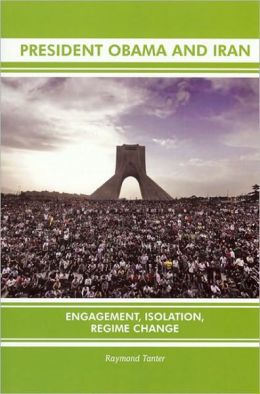|
Reviewed by Dr. Lawrence A. Franklin Dr. Tanter delineates four schools of approach to unraveling the Gordian Knot of America’s relations with the Islamic Republic of Iran. First, he describes the Engagement Option, favored by those who proffer a “Grand Bargain Approach.” Presumably, advocates of this option would recognize Iran’s sovereign right to enrich uranium and offer Tehran a security guarantee (a pledge not to attack and/or not to aid an attack by a third party). Extending the logic of this approach, such a deal would be seasoned by gestures of good will, such as a prisoner exchange. A lightening of sanctions could then follow. Subsequent lessening of bilateral tensions might then engender the appropriate atmosphere for initial confidence building measures between the U.S. and Iran’s regime. Second is the Obama administration’s dual track policy: the Diplomacy and Sanctions Option. This approach is almost exclusively focused on the multinational effort to persuade the Islamic Republic not to develop nuclear weapons capability. It is true that the multiple waves of increasingly tough sanctions are having a deleterious impact upon Iran’s economy. Still, the Islamic Republic’s ruling elites appear determined to tough it out. Nevertheless, this option’s effectiveness has been blunted by nationalist-minded Iranian citizens offended by a foreign-based campaign to deny Iran a sovereign right. Moreover, resentment in Iran is rising, even among the country’s normally pro-Western citizenry, that the sanctions are more harmful to the people than to their leaders. Finally, the fascist-theocratic regime’s raison d’être is anti-Americanism. Any compromise with the great Satan could cause the regime to unravel. Third, Tanter discuses the Military Option, as perhaps the only time-efficient way to halt or delay Iran’s ultimate transition to a nuclear power. He outlines how such a strike could be executed by Israel. He discusses the military and logistical complications that a strike would entail. Despite these difficulties, Israel’s Air Force believes a strike is doable. Despite the combative rhetoric, Israel’s leadership probably has concluded that a pre-emptive strike against Iran’s nuclear sites and necessary, prophylactic targets is not worth the military and political blowback that would follow. This decision is reinforced by the lack of confidence about what would be achieved by an attack. Moreover, the use of Israeli medium range ballistic missiles and/or submarine-launched ballistic missiles, would be politically disastrous. It also could lead to a rupture in normal ties with the United States. Fourth, Tanter embraces the Regime Change Option. Although he catalogs the salutary results of regime change, he does not offer a convincing blueprint for how this can be accomplished. For instance, Tanter quite correctly asserts that, following the overthrow of the regime, the birth of a secular, democratic republic should be anticipated. There is little likelihood that a “Persian Spring” would slide into the shoals of chaos and intolerance as has the “Arab Spring.” It is much more likely, with the rejection of the regime’s un-orthodox Shia doctrine of the valiyat-e-faqih (a leader supreme in theology and politics), that a substantial reduction in the clergy’s authority would ensue. The overthrow of the “Mullocracy” would elicit some unintended consequences, some predictable, others not. Regime change would ignite a renaissance of Persian culture and nationalism. However, Iran’s Sunni fundamentalist rival Gulf States will not welcome such an explosion of Persian pride. Nor would radical Islamic states and movements be enthralled. Yet, it would sever the current atypical alliance between Shia-controlled Iraq and Iran, thus re-establishing the balance of power in the Mesopotamian Middle East. This would prove beneficial to both the United States and Israel, a genuine “back to the future” setting. Tanter places too much confidence in the millions that make up the Iranian diaspora. They are disparate in ideology, selfish in temperament, and thoroughly penetrated by regime operatives. This is particularly the case in the United States. Like most émigré diaspora, as decades go by, they have become effete, corrupt, and disconnected from their native land. Moreover, there is no clear moral voice of leadership. Shah Junior has no fire in his belly and would prove as under-whelming a rally point as was the charlatan-deceiver Ahmed Chalabi in Iraq. Another key ingredient in Tanter’s regime change formula is the Mujaheddin-e-Khalq (MEK). While the MEK has proven helpful in the “outing” of key structural aspects of Iran’s nuclear weapons drive, it remains exceedingly unpopular among the Iranian people. The MEK actively aided Saddam’s regime in the 1980-1988 Iran-Iraq War. Moreover, the nature of this group remains ideologically rigid and cultist. Most significant, the MEK assassinated three unarmed Americans in 1978. As President Obama has laid out: there is no statue of limitations on the murder of American citizens. Tanter is sober in his criticism of the Obama policy toward the Islamic Republic. He should be. We are where we are with Iran because of the ineffectiveness of several previous administrations, both Democrat and Republican. We, and the Obama administration, will probably have to live with a fifth option: Containment of an Iran that continues to drive toward nuclear weapons capability. |


 President Obama and Iran: Engagement, Isolation, and Regime Change
President Obama and Iran: Engagement, Isolation, and Regime Change